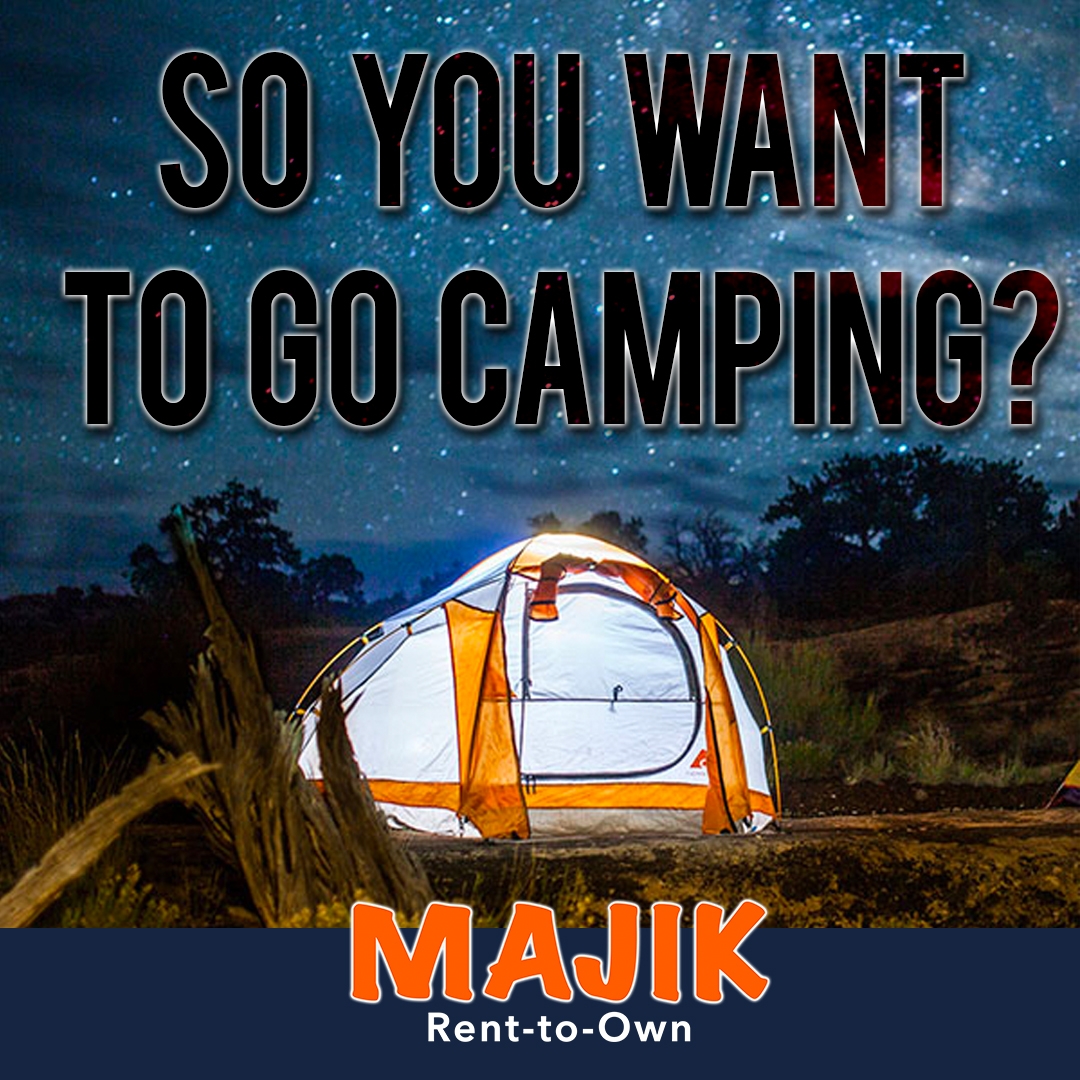
Even if you’re the most urban of creatures, the urge to get out of the city—to camp out, in fact—can seize your imagination at any time. If you find yourself contemplating car camping for the first time, but also find the gear and the prep to be a little daunting, don’t despair. We’re here to help.
The ultimate essential for beginner campers is, of course, an experienced outdoorsy person to help you. And if you’re lucky enough to have a friend with a campground reservation and a garage full of gear to share, then you have some of the work cut out for you.
But you can also do this camping thing completely on your own. You just need a few basic pieces of gear and then decide where you’re going. When going car camping for the first time, start with an overnight campout and keep it simple:
1. To save money, borrow or rent big-ticket gear.
2. To maximize your comfort, always bring appropriate clothes for cold and rain.
3. To satisfy your fresh-air-fueled hunger, bring plenty of food.
4. To keep your options open, camp close to home. (There’s no shame in bailing if problems arise.)
5. To ensure you get a good first impression, postpone your campout if the weather forecast is awful.
Essential Camping Gear
Camping is like staying in a primitive cabin, minus the cabin itself. So, in addition to your tent, pack as though you’re going to stay someplace where there’s little or no furniture, no electricity, no stove or refrigerator, and the cupboards are bare. In a developed campground you will have running water and a community bathroom a few hundred yards away. A typical campsite has a table (if not, you’ll want to bring one), a place to park a car and a place to pitch a tent.
You can keep your initial investment low if you borrow or rent the priciest items—the tent and your sleeping bags and pads. That’s a better strategy than paying bottom dollar for something that might not even last for a single camping trip. That said, if you are ready to invest in your very own camping gear, here are a few tips to help you decide exactly what to buy.
- The tent: If your budget can go a little bigger, then go bigger with your tent: A 3-person tent gives a cozy couple a little extra breathing room, and a family of four can more easily achieve harmony in a 6-person tent. You can also check the tent’s peak height if you want a tent that you can stand up in (that can make getting dressed and moving around easier to do). Vestibules outside the doors are nice for stowing muddy shoes and having two doors can help you avoid climbing over sleeping tentmates for late-night bathroom breaks.
Tip: Practice setting up your tent at home first. And don’t forget a properly sized footprint—if you have a ground sheet that's too small, it won't fully protect your tent floor, and if you have one that's too big, it can catch rainwater and pool it underneath your tent.
- The sleeping bag: When selecting your bag, temperature rating is a good place to start. If you’re planning on only going fair-weather camping, a summer bag is probably all you’ll need, but a 3-season bag will give you more leeway for unpredictable shoulder-season weather. If you’re always cold (or always hot), adjust accordingly. And no need to go with a super-snug mummy bag like backpackers use, when a rectangular camping bag will give your body more room to roam.
· The sleeping pad: A good sleeping pad is like the mattress on a bed, but it also has high-tech insulation to prevent you from losing body heat on the cold ground. Big air mattresses, like what your guests sleep on at home, might look temptingly plush, but their lack of insulation will likely leave you feeling cold. Take a look at specs when comparing sleeping pads—if one is thicker, longer or wider and has a higher insulation value (known as the R-value) — it will be more comfortable and warmer.
Tip: Set your tent, bag and pad up early, so you don’t have to do it in the dark.
- Lighting: Campsites don’t have illumination, so you have to bring your own. A flashlight is OK, but a headlamp frees up your hands for camp tasks. A lantern is nice for ambient light. (You can also build a campfire, but watch for fire restrictions.)
- Stove: A classic two-burner propane camp stove should do the trick. You won’t spend a fortune and you can cook breakfast and prepare your morning brew at the same time. Bring at least a couple of fuel canisters and a lighter, and fire it up once at home to be sure you know how it works.
- Cooler: You might already have one and it will probably work just fine. Just be sure you have enough capacity for your perishable food and a few cold ones, along with enough ice to keep ‘em that way. Some newer coolers with extra thick insulation make ice last quite a bit longer, though you’ll pay more for them.
- Pots, Plates, Cups and Sporks: You gotta bring everything necessary for food prep and consumption. You can raid your home kitchen, just don’t bring the fine china. And, unless you plan to take dirty dishes home, you’ll need a scrubber, biodegradable soap, a towel and a small washtub or two (one for dirty, one for clean).
Tip: Pack all your kitchen gear in a large clear plastic bin with a lid. It’s easy to store away at home and everything will be ready next time you want to camp.
- Camp Chairs: These are optional if you can sit at the camp picnic table, but downtime will be a little more enjoyable when you have a comfy place to perch. (And a hammock is even better, especially for afternoon naps.)
Tip: Mesh camp chairs let water drain easily and they dry quickly if left out in the rain or morning dew.
What to Wear Camping
Getting dirty is part of the fun, so wear things that look good grimy. (If you pack things in a plastic storage bin, it can double as your dish tub.) Cotton is usually a no-no because wet cotton can make you cold and miserable, even in surprisingly mild weather. Do bring a warm coat, plus long underwear, gloves, a beanie and warm socks for nighttime, along with a rain jacket just in case. Also pack some sensible (sturdy) shoes for your feet as well as a pair of slip-ons for midnight bathroom breaks.
Camp Toiletries
You need your prescription medications and hygiene items, of course. You can also bring bandages and other medicines from home, but a separate first-aid kit has comprehensive supplies in a nice compact case. Always plan for sun and prepare for bugs by bringing sunscreen and insect repellent. Because campground bathrooms sometimes run out of supplies, you should bring your own soap, toilet paper and a small towel. Hand sanitizer is nice to keep in your kitchen area.
Meal Planning for Camping
If you’re an accomplished chef and meal planner, then do your thing but be mindful that simple prep is better. Even if you’re not a chef, you should do a basic meal plan. It could be as simple as dinner out on the drive to camp, then cooking breakfast and having a lunch before breaking camp the next day.
You can go with boxed or canned entrees and side dishes, or fresh food or a combo of all of them. Be sure to bring plenty of snacks, and fixings for s’mores if you can’t imagine a campout without them.
If coffee or tea aren’t optional for you, then options range from instant coffee or tea bags to a stovetop percolator or teakettle.
Tip: Critters that hang around campgrounds are accomplished raiders, so don’t leave food or garbage out overnight, nor unattended. Seal up everything in a large plastic bin anytime you’re away from camp and lock it in your vehicle at night. In bear country, check the local regulations—there might be food lockers because bears have been known to break into vehicles.
Where to Go Camping
From national parks to RV parks, the possibilities are endless. Humanity’s enthusiasm for camping is also endless, though, so make your campground reservations well in advance. An online site that covers public lands nationwide is Recreation.gov. Private campgrounds can be found in several online sites, or you can do a Google Maps search.
Another option is campgrounds that are open on a first-come, first-served basis. Booking months ahead isn’t required, but it’s a good idea to check with the campground to get tips on the best time to show up in order to snag a site.
Unless you want to get in touch with your inner feral animal, avoid dispersed camping (no facilities) and primitive sites (pit toilets). You’ll be more comfortable in a developed campground, so look for one with flush toilets and running water. It’s also worth verifying that you have treated water coming out of a spigot. Natural water sources introduce added complexity and health risks.







